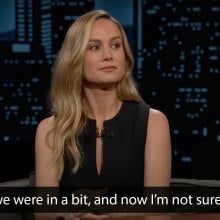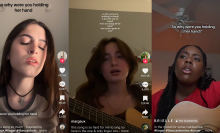The videos have all the trappings of a TikTok designed to go viral: an eager creator staring into the camera, poised to give the viewer a before-and-after look at completing a difficult physical challenge.
Yet so-called fear food challenges are dramatically different than the typical TikTok stunt. They aren't meant for anyone to attempt, but are instead produced for people going through or curious about eating disorder recovery.
In these videos, creators who indicate that they're in recovery often reach into a jar filled with scraps of paper labeled with one of their fear foods. Whatever word they pull out — "cheeseburger," "candy bar," or the name of a flavorful entree — they then make or buy and try to eat on camera.
Sometimes an individual fear food challenge TikTok garners millions of views. Collectively, the hashtag #fearfoodchallenge has more than 470 million views.
The comments are often overwhelmingly supportive of the creator. But other viewers come across the content with no understanding of why people in recovery have certain fear foods, and they leave cruel comments about the creator, demonstrating the risks of an algorithm pushing these videos into people's feeds with no context.
Eating disorder recovery experts say fear food challenge videos present both benefits and risks to the creator and the viewer. Particularly as people prepare for the new year by exploring wellness and food-related content on TikTok, it's important to know what the content is, and how it could help or harm someone interested in it.
1. What is a TikTok fear food challenge?
While each person's journey with eating disorder recovery is different, attempting to eat a feared food is often part of treatment, says Dr. Jason Nagata, an adolescent medicine specialist who cares for youth with eating disorders at UCSF Benioff Children's Hospital in San Francisco.
A person living with an eating disorder, including the conditions anorexia nervosa, binge-eating, and bulimia nervosa, may develop anxiety or fear related to foods that trigger negative thought patterns. They might worry that the food will lead to weight gain, or it may violate a rule they have set, like not eating a certain carbohydrate or using a condiment that contains fat.
People struggling with or recovering from an eating disorder experience visceral and real fear when faced with such foods. Nagata says that one stage of recovery is to be able to eat a wide range of foods, including items that might have been previously difficult.
In treatment, trying a fear food typically happens with the support of a therapist who can offer support.
"The first time that you face down one of these fear foods, I think your best chance of success is to do it with a professionally-licensed provider who is trained to support you...," says Nagata, adding that not everyone has access to mental health care.
On TikTok, this recovery exercise has been turned into a "challenge."
There is no supportive therapist, though the creator may be with a friend, loved one, or partner. Instead of depicting themselves consciously deciding which food to eat, creators inject the element of surprise. They often select the item from a jar filled with pieces of paper labeled with different fear foods. Videos are frequently edited to show them ordering the food from a menu, preparing it, or purchasing it from the grocery store.
While some creators share footage of their mild but brief discomfort with the food, such as grimacing, pulling back, or pausing, they often finish what's on their plate. Some nod or smile affirmatively to signal they're enjoying the food, or they remark on how much they missed eating it.
In the numerous TikToks that Mashable viewed, there were no links to TikTok's resources on eating disorders and their treatment. A spokesperson for TikTok told Mashable that the videos won't be removed unless they violate the platform's community guidelines by showing or promoting disordered eating or dangerous weight loss behaviors.
2. What are the risks and benefits of a TikTok fear food challenge?
One overall goal of recovery is to be able to eat healthful meals in a social setting with other people, in a way that doesn't reduce a person's quality of life by leading to significant eating disorder-related symptoms, like debilitating thoughts or anxiety, says Nagata. In this sense, being able to reclaim a fear food is an important part of recovery.
Nagata says that seeing creators who are attempting to reduce their fear in a TikTok can help normalize the situation. That can be empowering for some viewers, who may feel less alone with their own struggles as a result. And supportive communities that emerge from comments and direct messages with a creator, or their followers, can be beneficial as well.
Yet Nagata has reservations about the content. While creators do receive overwhelming encouragement from those who understand what it's like to have or recover from an eating disorder, commenters without that knowledge may harass or insult them, says Nagata. (Creators can use TikTok's controls to block, limit, and filter comments.)
Additionally, he worries that some fear food challenge TikToks might contain misinformation about the exercise, or about treatment in general. The videos may show less healthy ways of trying a fear food, like consuming too much in short periods of time instead of starting slowly. For those with anorexia nervosa who also go through cycles of binge-eating, the act of eating large amounts of food in order to conquer a fear may trigger a binge-eating episode.
Then there's the risk for someone experiencing an eating disorder that viewing a fear food challenge TikTok could lead them to compare themselves with the creator. Negative comparisons are a common feature of eating disorders and can revolve around body size differences and food preferences.
Someone viewing a TikTok of a creator eating a certain food that they don't find difficult, for example, might question whether they really have an eating disorder, and as a consequence, if they actually need treatment. At the same time, if someone in recovery is viewing a lot of these videos but not having success in their own efforts to reduce fear of specific foods, they might feel worse about themselves, says Nagata.
TikTok's algorithm may also pose an inadvertent risk to both creators and viewers. If creators are rewarded with increased views and engagement when they post a fear food challenge, they may create more of them to build their audience, even if it negatively affects their recovery. The stress of filming and curating videos can be taxing, says Nagata. And viewers may encounter triggering fear food challenge content, as well as be encouraged to watch it repetitively, thanks to the algorithm. (Concerned viewers can filter the phrase "fear food" or the #fearfoodchallenge hashtag from their For You or Following feeds, or ask the app to reduce the suggestion of related videos.)
Dr. Doreen Marshall, a psychologist and CEO of the National Eating Disorders Association, says the videos may help raise awareness of eating disorders but worries about TikToks lacking context about the creator's recovery. She notes that care should be taken in drawing conclusions about whether fear food challenges are part of someone's treatment.
Many individual videos don't include details about the creator's eating disorder and whether they're actually in treatment. They also don't depict fear food exercises as they happen in treatment, which begin with a very slow introduction.
Scenes of what happened after the video ended aren't included, either. There's no way for a viewer to know whether the creator experienced a minor or major setback following their challenge, like excessively exercising or a pervasive preoccupation about their body size.
Marshall says that what gets left out or lost in translation in a challenge TikTok may give some viewers the impression that the path to recovery requires the progress featured in those videos.
"What we want to recognize is that eating disorders are not a monolith," says Marshall. "Recovery doesn't look the same for everyone."
Both Marshall and Nagata urge people who are negatively affected by creating or viewing fear food challenge TikToks to seek help or support from a trusted friend, loved one, or mental health professional.
3. Alternatives to a TikTok fear food challenge
Jessica Flint, founder & CEO of the eating disorder support system Recovery Warriors, understands the inspirational aspect of fear food challenge TikToks but says they can have adverse effects.
Flint, who recovered from an eating disorder, says the visual medium is likely to encourage a fixation on a creator's body size. That can lead to relentless comparisons, or to feeling invalidated if the majority of creators are people in recovery from anorexia but a viewer is someone in a bigger body.
In the Recovery Warriors Courage Club, a virtual support group that requires a paid membership, Flint says food challenges play a motivating role, but without the pressure to eat something too ambitious or create visual content that might go viral.
Flint says members of Courage Club are encouraged to break dozens of their own food rules, but slowly and stepwise. This might mean eating a red apple instead of a green one, swapping broccoli for zucchini, or ordering a different item from the menu of their favorite restaurant.
The idea is to gradually help someone in recovery understand that they are capable of eating a diverse range of foods, not just what their brain convinced them was tolerable during their illness.
When people share their "variety victories," they do so on a platform that focuses on text rather than photos. Members' avatars may not even be a picture of themselves. The audience comprises people who are also in recovery, with the support of a doctor, dietician, or therapist, and has been vetted by Flint's team of facilitators.
Courage Club, which has a waiting list, isn't the only alternative to a TikTok fear food challenge, but it's one example of how an important part of recovery can look off a major social media platform.
Flint also recommends different types of media, particularly those without a video or visual medium, like blogs and podcasts. Flint prefers these resources over videos because someone can "create [their] own meaning" from hearing a voice and story, rather than looking at the speaker's body and comparing it to their own.
"There's tons of recovery support that doesn't require you to watch videos that are fed by algorithms," Flint says.
If you feel like you’d like to talk to someone about your eating behavior, text "NEDA" to the Crisis Text Line at 741-741 to be connected with a trained volunteer or visit the National Eating Disorder Association website for more information.
Topics Mental Health Social Good TikTok





























